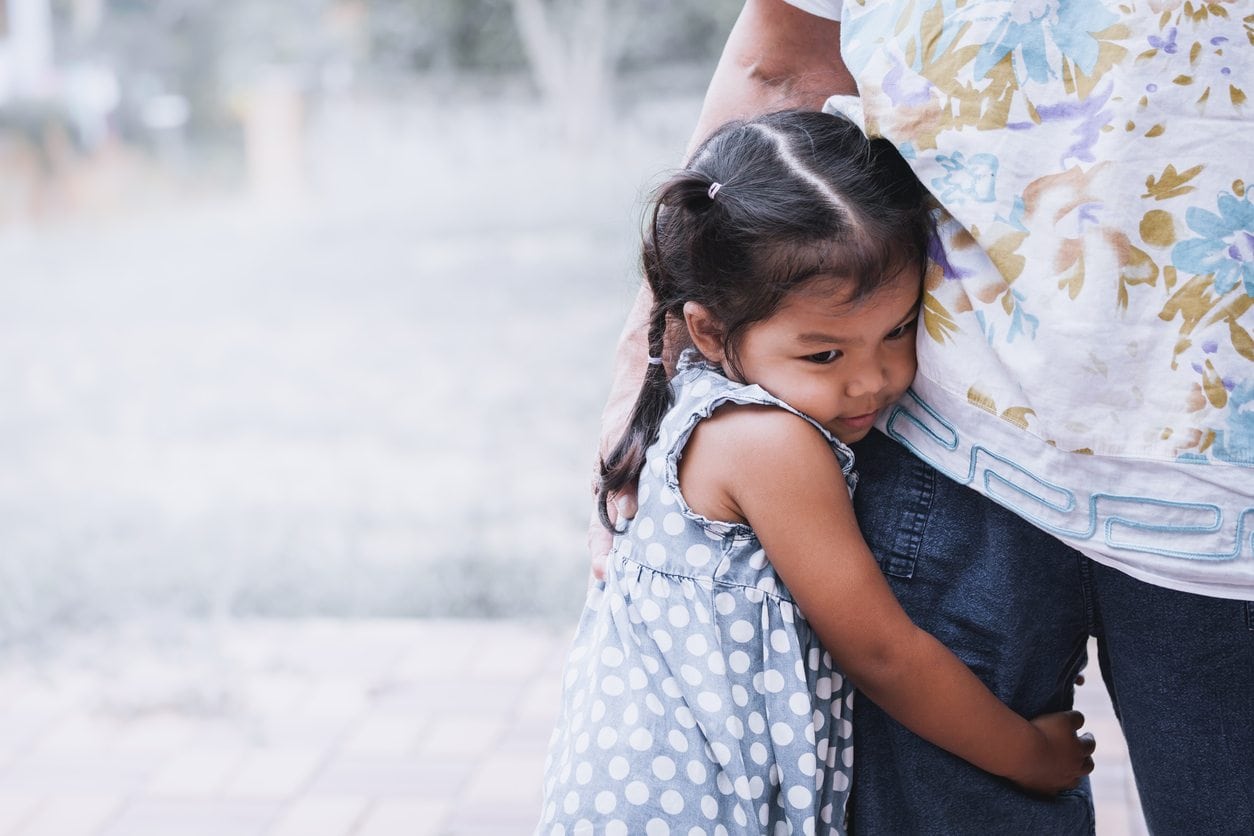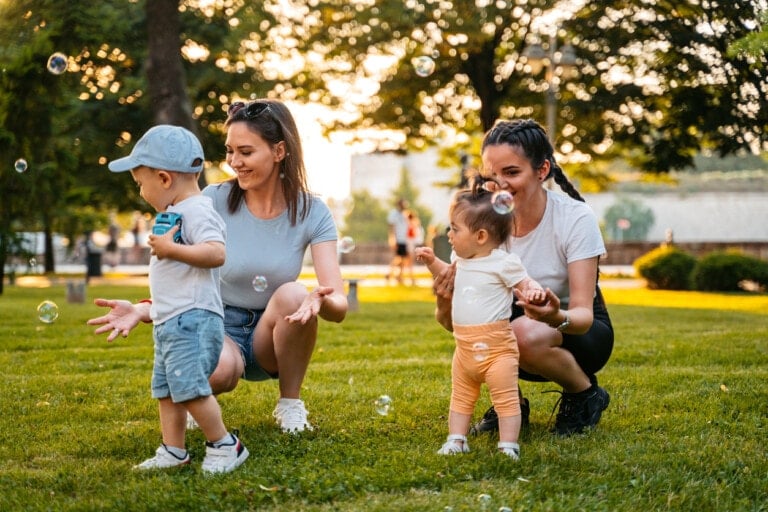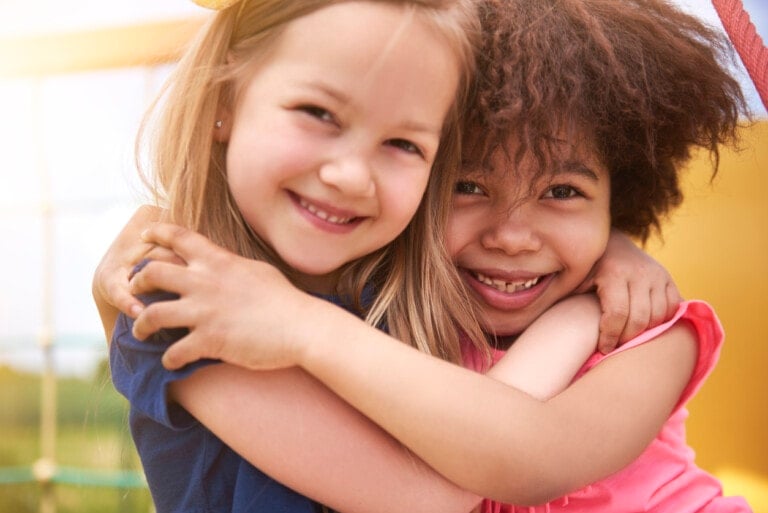It’s normal for our children to feel scared at times. Fear is a good thing in certain situations. It teaches us to pause and assess things. Being cautious helps keep us safe because we hesitate before picking up spiders or jumping off something high. As our children grow, it’s natural for new fears to appear; in fact, they often appear at predictable times because many fears are a common and typical part of child development.
Even though it’s normal to be fearful, it can be hard to watch our little people grappling with worries and uncomfortable feelings. As a parent, it’s natural that we want to minimize their concerns and soothe them; however, how you respond to their fears can make a big difference in them learning how to cope with fears and anxiety. We’ll cover some typical childhood fears and strategies you can use to help your worried child manage distress and uncomfortable feelings. Looking ahead will not only help you know what to expect, but you will also feel more prepared and confident in supporting your child.
Common Fears for Babies and Young Children
Babies and young children don’t fear scary movies, ghosts, public speaking, etc. They are anxious about things that might threaten their survival, and their fears are more about instinct, such as being separated from you, loud noises, falling (or heights), and strangers.1 These instincts influence how they react to a fearful or worrying situation. While we might see emotions, they often display a physical response to things or an automatic reflex. Some reflexes include:
Moro Reflex
Don’t confuse this one with the startle reflex. The Moro reflex is when your baby extends and arches their arms, legs, and fingers and then brings their arms back into their body. It happens when they feel like they are falling or in response to a sudden loss of support. The reflex usually disappears between 3-6 months. It’s a survival instinct that helps young infants cling to their mother when they have lost their balance or grip, as it causes them to embrace and regain their hold on their mother’s body.2
Startle Reflex
This is a subconscious response to sudden or threatening things in our environment (and it’s not just babies who have a startle reflex; we still have it as adults). It can include a fear of, or reaction to, loud noises or sharp movements. Essentially, our body very quickly and automatically reacts to try and protect itself or prepare for quick action or some motor task. We might blink, tighten, or constrict our neck muscles (flinch) and increase our heart rate, among other things. This is another survival instinct that helps our body prepare to protect itself somehow.3
Separation Anxiety
Once our babies get a bit bigger and start understanding the world around them, the next fear is focused on another survival instinct: making sure mom and dad don’t leave them. This fear is common in childhood. Our little people are reliant on us for their safety, and so around 6 to 8 months, they develop stranger anxiety (or fear of new people) and separation anxiety. It’s because, around this age, they realize that although something has disappeared from their sight, it still exists in the world.4 So initially, they may cry as they don’t know that you will return, but later on, they might cry and become fearful and distressed because they want you to return.
Common Fears for Older Kids
It’s common for our toddlers to develop new fears that seem a bit random or seemingly come out of thin air. Suddenly, they may become fearful of things, places, or people that never seemed to bother them before. Although the content of their fears might seem a little strange or irrational, these childhood fears are just as developmentally appropriate as the survival instincts of infants. Some common fears can include:5
- Fear of the dark
- Fear of dogs or loud animals
- Fear of insects, snakes, spiders, etc.
- Fear of going to school or childcare
- Fear of going outside or leaving the house
- Fear of being left home alone
- Scary TV shows or the news
- Storms or natural disasters (like fire)
- Injury or illness and doctors
- Death
- Fear of failure and rejection
Where Are These Fears Coming From?
Your child has started to explore their world and is becoming increasingly independent. While this is an essential state of development, it can leave children feeling vulnerable, small, and out of control in their world. They are also becoming increasingly exposed to new things, which they need to categorize to learn about and understand how the world works.
New things might automatically be scary because they don’t understand them, or they have a negative experience of something (like being surprised and frightened by a loud dog barking). They then categorize that thing and similar items as risky or dangerous.5 Also, preschoolers are developing their imaginations, which feeds into fears of the unknown as they use those imaginations to fill in the gaps. For example, they might become afraid of the dark because they can start to imagine and fear what is hiding in the dark as they are worried about what is out of sight or what they can’t see.6
How Can Parents Help Their Kids Manage Common Fears?
There are several ways you can support your child in managing common fears, including:7,8
Don’t Avoid Them
If you avoid fears or triggers, it can feed into the idea that they are something to be scared of. Instead, you can support your child by teaching them to cope with the worry.
Play Detective
If you can uncover what your child is fearful of or why it can help to reduce their sense of confusion, you can better match the appropriate coping strategies. You can also address it by reality-checking or sharing helpful information to reduce the fear.
Don’t Dismiss It; Validate It
It’s a fine line here. You don’t want to dismiss their fear, but you also don’t want to buy into it either (and confirm to them that “yes, that is something to be scared of”). Smirking, teasing, or dismissing them won’t help, but validating their feelings can help them feel connected, safe, and heard, which can go a long way to reducing their distress. Instead of saying, “Yes, that is scary” (which validates that it’s something to be frightened of), validate the emotion instead. For instance, “I can see you feel scared right now.” It’s a very slight but crucial distinction.
Problem-solve
If you can figure out the fear, work together to find a way to tackle it. If they are afraid of storms, for example, you could do some research and find out why thunder and lightning happen (sometimes knowledge helps break through fear when they understand it). Or if they worry about the dark, you could check their room together before they go to bed. The most crucial part is that your child feels they have some control over how they will manage the situation and the fear. When they own it, they feel confident and capable, which reduces the intensity of the fear.
Anxiety Versus Normal Childhood Fears
How do you know if it’s just a common childhood fear or something else, like anxiety? Anxiety in children is more than just a simple fear. Most children will have fears or worries of some kind, but anxiety stops them from doing things they want or interferes with parts of their lives, like school, friendships, or family life.4 You might also notice that their fears are not developmentally appropriate. For example, separation anxiety is normal in infants and toddlers, but for older children (generally aged 8 and over), this might be an indicator that something else is going on.4 You might also consider seeking support if they have a very strong or disproportionate response to something — i.e., their reaction seems blown out of proportion for how small or minimally risky something might be.
Childhood fears are normal, and chances are, they will outgrow them with some support and as they start to understand the world around them a little better. There are many things you can do to help them develop tools and strategies to conquer their fears. It’s also important to understand when normal fears are evolving into something else, like anxiety. Ensure you seek professional information and advice from a trusted health professional if you are concerned.































